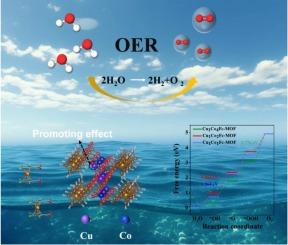二茂铁基金属-有机骨架中铜掺杂对钴活性位点的电子调制促进析氧反应
IF 4.1
3区 化学
Q1 CHEMISTRY, ANALYTICAL
引用次数: 0
摘要
在能源化学领域,调制金属活性位点的电子态为优化mof基材料的电催化性能提供了一种很有前途的策略。本文采用溶剂热法在CoFc-MOF合成过程中原位引入铜离子,合成了高效的CoCuFc-MOF催化剂。结果表明,CoFc-MOF在保持配位构型的同时,通过铜原子掺杂诱导的电子吸附效应对钴催化位点的电子结构进行了调制。因此,优化后的Cu1Co2Fc-MOF在10 mA·cm−2下的OER过电位为238 mV, Tafel斜率为48.4 mV dec−1。24 h耐久试验过电位仅增加5%,整体劈水试验所需电压较低,为1.686 V。令人惊讶的是,DFT计算表明,CoFc-MOF结构中的铜集成显著调节了钴活性位点的电子构型,从而重构了OER途径中的限速机制。通过将OER速率决定步骤从*OOH到O2转换为*OH到*O, Cu1Co2Fc-MOF的理论过电位从0.546 V显著降低到0.173 V。本文章由计算机程序翻译,如有差异,请以英文原文为准。

Electronic modulation of cobalt active sites via copper doping in ferrocene-based metal-organic frameworks for enhanced oxygen evolution reaction
Modulating the electronic states of metal active sites offers a promising strategy for optimizing the electrocatalytic performance of MOF-based materials in the energy chemistry field. Here an efficient CoCuFc-MOF catalyst was synthesized by in situ introduction of copper ions during the synthesis process of CoFc-MOF via solvothermal method. The findings indicate that while the coordination configuration of CoFc-MOF remains preserved, the electronic structure of cobalt catalytic sites undergoes modulation through electron adsorption effect induced by copper atom doping. Thus, the optimized Cu1Co2Fc-MOF exhibits a 238 mV OER overpotential at 10 mA·cm−2, and a 48.4 mV dec−1 Tafel slope. Furthermore, only 5 % increase of overpotential is observed during 24 h durability test and a lower voltage of 1.686 V is needed to perform overall water splitting experiment. Surprisingly, DFT computations disclose that copper integration within the CoFc-MOF architecture significantly modulates the electronic configuration of cobalt active sites, consequently restructuring the rate-limiting mechanism in the OER pathway. It dramatically reduces the theoretical overpotential from 0.546 V in Cu1Co4Fc-MOF to 0.173 V in Cu1Co2Fc-MOF by converting OER rate-determining step from *OOH to O2 to *OH to *O.
求助全文
通过发布文献求助,成功后即可免费获取论文全文。
去求助
来源期刊
CiteScore
7.80
自引率
6.70%
发文量
912
审稿时长
2.4 months
期刊介绍:
The Journal of Electroanalytical Chemistry is the foremost international journal devoted to the interdisciplinary subject of electrochemistry in all its aspects, theoretical as well as applied.
Electrochemistry is a wide ranging area that is in a state of continuous evolution. Rather than compiling a long list of topics covered by the Journal, the editors would like to draw particular attention to the key issues of novelty, topicality and quality. Papers should present new and interesting electrochemical science in a way that is accessible to the reader. The presentation and discussion should be at a level that is consistent with the international status of the Journal. Reports describing the application of well-established techniques to problems that are essentially technical will not be accepted. Similarly, papers that report observations but fail to provide adequate interpretation will be rejected by the Editors. Papers dealing with technical electrochemistry should be submitted to other specialist journals unless the authors can show that their work provides substantially new insights into electrochemical processes.

 求助内容:
求助内容: 应助结果提醒方式:
应助结果提醒方式:


